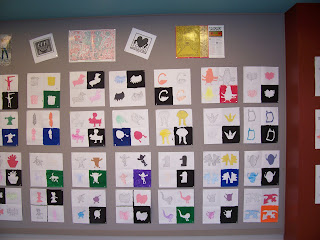
His artwork became a sort of brand, when he began doing advertisements for various products. Even though Haring is no longer living, I've noticed many ads that are still heavily (if not, downright theiving!) influenced by his work. Haring, who some have labeled the 'Godfather of Graffiti Art', started out on a criminal path. He was arrested several times for his early graffiti chalk drawings on the subway walls of New York City. Eventually, he was asked to create paintings and sculptures for galleries and became a well known artist for his time. Haring became a social activist with his artwork, often times working with children and communities to raise money for AIDS organizations and children's programs. Sadly, Haring died an early death at age 32 of complications relating to the AIDS virus.
 Students usually are excited anytime I show them works of graffiti art, but most of them only have the idea of illegal 'taggers' in their heads. I love to show them Keith Haring, because he became a legitimate artist and also because his art is not always what we think of when we hear the word, 'graffiti'. For this lesson, the students were to create their own 'symbol' in the style of Keith Haring. I urged them to either; add arms and legs, halos, fire or wings to inanimate objects (these are methods of symbolism that Haring often used) and to use a shape that could be made into a stencil and traced. When each student finished their posterboard paper stencil, they traced around it in four different squares of a square paper. I incorporated some of the Elements of Art into this project by having them do; ink lines for LINE, a construction paper shape for SHAPE, the use of a texture plate rubbing for TEXTURE and by painting the negative space for SPACE. We had some very unique art come out of this project. Take a look!
Students usually are excited anytime I show them works of graffiti art, but most of them only have the idea of illegal 'taggers' in their heads. I love to show them Keith Haring, because he became a legitimate artist and also because his art is not always what we think of when we hear the word, 'graffiti'. For this lesson, the students were to create their own 'symbol' in the style of Keith Haring. I urged them to either; add arms and legs, halos, fire or wings to inanimate objects (these are methods of symbolism that Haring often used) and to use a shape that could be made into a stencil and traced. When each student finished their posterboard paper stencil, they traced around it in four different squares of a square paper. I incorporated some of the Elements of Art into this project by having them do; ink lines for LINE, a construction paper shape for SHAPE, the use of a texture plate rubbing for TEXTURE and by painting the negative space for SPACE. We had some very unique art come out of this project. Take a look!






































































